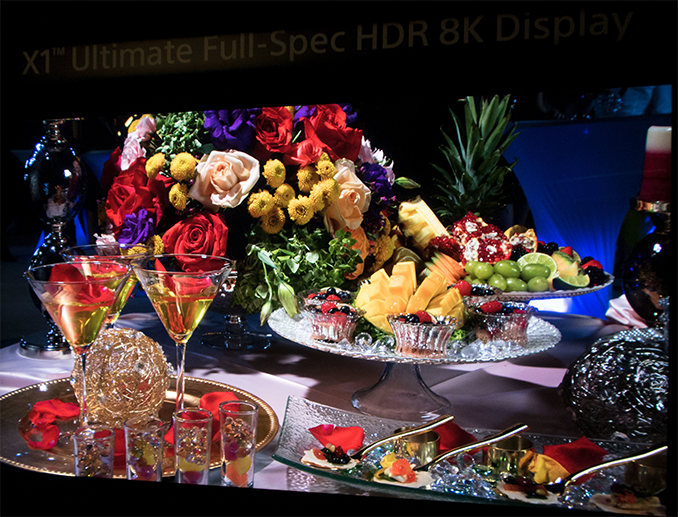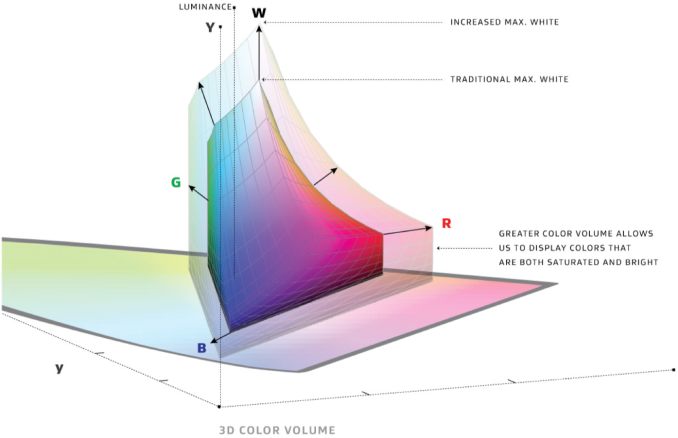Sony Demos Prototype of ‘Full Spec HDR 8K Display’ with 10,000 Nits Luminance
by Anton Shilov on January 11, 2018 7:00 AM EST
LAS VEGAS, NV — Sony demonstrated a prototype of its 8K display with a peak brightness of 10,000 nits at CES 2018. The company did not disclose when it plans to commercialize the product, if at all. While the display’s main feature is extremely high luminance, it packs a bunch of other important technologies, including a new SoC and a new method to keep the contrast ratio high.
Sony calls the prototype it demonstrated at its CES 2018 press conference the “X1 Ultimate Full-Spec HDR 8K Display”. The 85” device with a 7680×4320 resolution relies on an unknown display technology and an undisclosed backlighting system to enable a peak luminance of 10,000 nits.
To put the 10,000 nits number into context. Contemporary high-end UHDTVs offer peak brightness at 1000 – 1500 nits; to get the Ultra HD Premium logo on a TV, the device should have a peak luminance between 540 and 1000 nits (subject to black level performance) and VESA’s DisplayHDR certification currently tops at 1000 nits (black level performance has to be met to get the badge). Then, there is Dolby’s Pulsar reference monitor for Dolby Vision post-production with a peak brightness level of 4000 nits. So, 10,000 nits is a lot. In fact, the Dolby Vision specification supports maximum luminance of 10,000 nits.
A big question is whether this is something that is eagerly awaited by the industry in the foreseeable future because in addition to peak luminance, display panels need to properly support large color spaces, but clearly this is Sony’s technological achievement.
It's interesting to note though that while the most eye-catching aspect of the prototype set is its brightness, that's not the only reason Sony is showing off the set at CES. The display is also a vehicle to show off the company's latest X1 picture processor, in this case being equipped with a pre-production version of Sony’s X1 Ultimate processor that features two times higher “real-time processing power” compared to the current-gen X1 Extreme. The latter is known to support multiple HDR-branded video post-processing techniques, so it is logical to expect its successor to further develop such capabilities.
While high luminance and a wide color gamut are important, contrast ratio is a yet another factor required for a stunning picture on a screen. When it comes to displays with LED backlighting (and I doubt that we are dealing with an OLED-based prototype), precise control of LEDs and calibration of their light beams is a method used by manufacturers to achieve deep blacks today. Several years ago, Sony already demonstrated a 4K display with a 4000-nits brightness featuring its Backlight Master Drive technology that ensured both incredible luminance and a high contrast ratio with its 1000 independently controllable lighting zones. Since technologies tend to evolve, we may be looking at a successor of the Backlight Master Drive tech to be used on the "X1 Ultimate Full-Spec HDR 8K Display”, but a linear growth of the number of controllable lighting zones is hardly the only option that Sony has at hands.
Sony naturally does not disclose any additionally technical details about its prototype. As such, the key takeaways here is that the company had developed an ultra-bright backlighting along with a way to keep the display’s contrast ratio at a decent level as well as a processor that can handle content with peak luminance of 10,000 nits and presumably in a wide color spectrum.
Related Reading:
- Philips Demos 328P8K: 8K UHD LCD with Webcam, Docking, Coming in 2018
- Dell’s 32-inch 8K UP3218K Display Now For Sale: Check Your Wallet
- Dell Announces UP3218K: Its First 8K Display, Due in March
- VESA Announces DisplayHDR Specification: Defining HDR Capabilities In Performance Tiers
- Panasonic Develops IPS Panel with 1,000,000:1 Contrast Ratio, 1000 Nits Brightness
- CEATEC 2016: Sharp Showcases 27-inch 8K 120Hz IGZO Monitor with HDR, also 1000 PPI for VR
Image Source: Tek.No
Source: Sony












21 Comments
View All Comments
zepi - Thursday, January 11, 2018 - link
High peak brightness doesn't mean that standard background on white web page would be shown at 10 000nits.It just allows us to have proper specular highlights in chrome bumpers of the the cars etc. Ie. those little few pixel sized highlights that you see all the time in real world when you walk down the street in a sunny day.
Pinn - Thursday, January 11, 2018 - link
But isn't level 1024 (10-bit) peak brightness, whether on a web page or a bumper?DanNeely - Thursday, January 11, 2018 - link
Only if your display brightness is cranked to max and your OS is stupid about it.A complaint I've seen elsewhere is that in HDR mode W10 sets the maximum brightness level for normal desktop white at a level suitable for a relatively dark room not one with really bright lighting/outdoors sunlight and doesn't provide an easy way to change if.
nevcairiel - Thursday, January 11, 2018 - link
When you output SDR, sure. If you output in HDR mode, you would hope that Windows does some magic to reign in the desktop into the 0-100/120nits range, as to not cause crazy results.A different transfer function is used to allocate more bits to the important parts, and less bits to the less important parts of the brightness range (we already do that in SDR with the typical gamma curves as well)
nevcairiel - Thursday, January 11, 2018 - link
On that note, displays are also not designed to show a full 10,000 nit white screen, because that would be truely blinding, so I would assume that to be literally impossible.Santoval - Thursday, January 11, 2018 - link
Indeed, very high brightness allows the monitor to show "whiter than white" highlights and details, like sunlight reflections off shiny surfaces, while high contrast helps to show very deep "blacker than black" blacks, and more grey shades in gradual transitions from white to black or bright to dark colors (however for that to work well you require at least an 10 bit display, or else you suffer the horrors of color banding).The above specular highlights are not often "pixel sized" (especially in 85" screens) though, and for all the above to work the content needs to have been mastered at least at a level of quality and detail of what your TV/monitor can support. In bad quality content you will see no to barely any difference. I am also quite sure that under a testing or calibrating (probably not under normal use) mode it should be possible to expose all the nits of this screen, preferably with adequate eye protection.
nunocordeiro - Thursday, January 11, 2018 - link
Hey Anton! Good piece on the technical side, but you missed out on an important piece of information. What does the image feel like? From your subjective point of view, does it look awesome? Is it a big step? Do you actually wish you had that in your living room?Pork@III - Thursday, January 11, 2018 - link
Looks good! Please don't search for price of this device except if you is not billionaire.edzieba - Thursday, January 11, 2018 - link
"A big question is whether this is something that is eagerly awaited by the industry in the foreseeable future because in addition to peak luminance, display panels need to properly support large color spaces"If the display supports remapping from ACES (https://en.wikipedia.org/wiki/Academy_Color_Encodi... it can in theory perfectly emulate all gamuts encompassed within its own physical gamut volume.
HideOut - Thursday, January 11, 2018 - link
So your comment about multiple HDR techs is outdated, didnt they merge the specs just a few days ago?